Sunapee
Ski Tows
Sunapee
Village, NH
1938
- 1976History ~
Listings by the Year ~ Memories ~
Recent Photos and Visiting the Area
History
| The Sunapee Ski Tows area
was initially built in 1938, when the Sunapee Outing Club constructed an
expert trail on Blaisdell Hill. Thereafter, the Sunapee Recreation
Committee built a tow for the following season, and another tow the year
after. The area provided affordable skiing for decades before closing in
the mid 1970's due to insurance reasons. Today, the area is the Tilton
Park and is publically accessible for outdoor recreation.
Jonni Gallup has the best history of this ski area: The Sunapee
Ski Tows were opened in winter of 1938/39 by the town of Sunapee on Blaisdell Hill.
It opened with one tow and shortly after in 1940 a second tow was added further up
the hill on the adjacent property. Ernest Holt was the tow operator and he was paid
50 cents an hour to run the tow. School children were recruited to maintain the trails
and pack the snow. A warming hut was added at the base in 1954. The little
ski area was then destroyed by fire in the mid seventies. They reopened the next year
under a temporary license and using a second hand rope for the rope tow. The tows closed
after that season for insurance reasons. Both tows were operated by Model A engines and
both engines remain in the woods to this day. The cables for both tows are (believe it or not) in my
barn! They were sold to my grandfather after they closed.
|
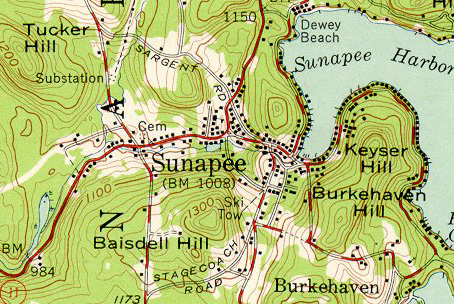
1955 UNH Topo map of the ski area. Note
the beginner tow on Stagecoach Road, with the upper tow not depicted.. |
|
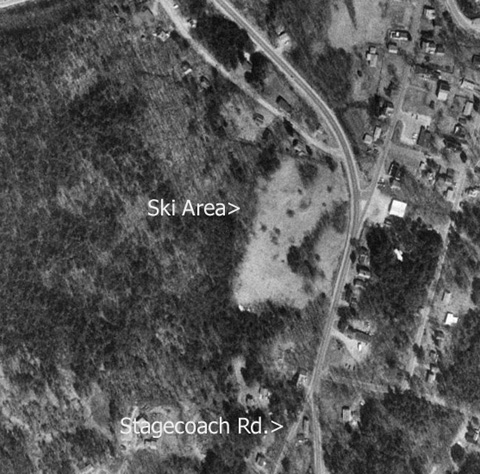 |
Today, the area is known
as the Albert Tilton Park, a multi-use outdoor park on Stagecoach Road.
For more information,
please
visit this blog on the Nona Playground.
Left - a 1998 View of the former ski area.
The lower beginner slope is delineated. The upper expert area has
completely grown in, and is located between the words Ski Area and
Stagecoach Road. |
Listings by
the Year
| Year |
Lifts |
Trails |
Other Info |
Source |
| 1938-1939 |
Ski tow is planned but uncertain |
Blaisdell Hill Trail (350' drop on 0.4
miles, fast trail for intermediates), Lower Village Trail (450'
drop in 0.9 miles, novice). |
Inquire information from Mrs. Alice
Domina, Secretary, Sunapee Recreation Committee |
1938-1939 NH Winter Sports Map |
| 1939-1940 |
Ski tow |
Same as above plus open slopes at foot
of trails |
Operates weekends and by arrangement,
Inquire information from Mrs. Alice Domina, Secretary, Sunapee
Recreation Committee |
1939-1940 NH Winter Sports Map |
| 1940-1941 |
2 700' tows |
Same |
Same |
1940-1941 NH Winter Map |
| 1946-1947 |
2 700' tows |
Two trails, 0.4 miles (intermediate)
and 0.9 miles (expert), open slope. |
Operates weekend, holidays, and by
arrangement. Inquire from Mrs. Dorothy Jones, Secretary, Sunapee
Recreation Committee |
1946-1947 NH Winter Map |
| 1947-1948 |
Same |
Same |
Same |
1947-1948 NH Winter Map |
| 1948-1948 |
2 consecutive 700' tows |
Open slope and expert trail, 0.5 miles
long. |
Lower tow and open slope lighted
weekends. Operated by the Sunapee Recreational Committee |
1948-1949 NH Winter Map |
| 1949 |
2 700' tows |
Open slope, 1/2 mile expert trail.
Lighted slope. |
Open weekends |
Where to Ski, provided by Wayne Silver |
| 1951 |
2 consecutive 700' tows |
Open slope and 0.5 mile long expert
trail |
Open Friday-Sunday, holidays by
Sunapee Recreation Committee. Lower tow and slope operated evenings |
1951 NH Winter Guide |
| 1959 |
2 700' tows |
not listed |
Operating Friday-Sunday by the Sunapee
Recreation Committee |
1959 NH For Winter Sports Guide |
Memories
David, a NELSAP
reader, remembers skiing at this area. Here's his personal account which
provides the best description of the area:
"In Sunapee NH, on route 103B, just about
a half mile from the harbor, and just up the road a bit from the High School,
there was a ski area that I skied in the late 60's and early 70's. It had
a rope tow and maybe 3 trails or so, mostly down an open field of sorts.
My grandparents owned a house directly across the street from the area
and I often hiked in the summer up to the top of the tow. From there, a
steep trail led further up a considerable ways, and at the top was
the old model T engine in an old building that once housed the top
of the second rope tow. From that spot, a trail led down the shoulder
of the hill, before taking a 90 degree right turn and heading down to meet
one of the lower trails about halfway down to the lower rope tow loading
area.
My Mom, who skied there in her childhood
in the 40's talked of skiing the upper section of the hill, but by the
late 1960s the upper trails were starting to grow in, and the upper rope
tow was removed except for that engine at the top. But I had many
a fun day skiing that lower area, and enjoying the rope tow while I learned
to ski. I never recall paying anything to ski there, but I have to admit
that it was a small area where everyone knew each other."
Another
NELSAP reader, Carl Gissler, remembers a bit about
this ski area: I remember the rope tow at Sunapee, very well. I never skied
there but I grew up in Sunapee and my school bus went right by it. When I did
ski, I went over to the state park where my grandfather operated the rope tow.
Sandy Alexander:
The lower tow served a very gentle slope. When I attended elementary school in
Sunapee in the mid 50s, we got out of class
on Wednesday afternoons for
free ski lessons at the ski hill. Instruction was provided by volunteer parents.
If it had snowed, first we had to pack the hill by sidestepping the entire run;
only then could we use the rope tow. As we developed into little speed demons,
the lower slope was basically good for one straight shot with a hockey stop at
the bottom. We would practice that final turn in one direction and then the
other.
At the end of the afternoon when most had quit, a couple of us would ask old Mr.
Boyce to shift the engine into second or third gear and then we'd fly up the
hill for those last couple of runs. He used to get a kick out of watching us and
we had to pay attention. Someone's mitten got yanked off once at the top right
at letting go; it stayed on the rope, went into the engine shack, around the
wheels and back out the top, dropping off right at the feet of its owner who was
just standing there wondering how that had all happened in a matter of seconds!
There was a small warming hut at the top of the lower tow, only opened if the
weather was bitterly cold.
The upper tow only operated on weekends if staff or the number of skiers made it
feasible. It was quite a bit steeper, which made it more of a challenge to hang
on to the rope if it was the least bit wet and heavy. We smaller kids learned to
jump on right after someone larger and stronger who could hold the rope up. The
upper run wasn't as well packed out as the lower and was definitely more
challenging and fun. One day I ran right into a large tree in the middle of the
upper part; it snapped the tip of my ski off and wrenched my foot half out of my
leather boot. I wanted to ski down on one ski but the adults made me get in a
toboggan. My dad glued and screwed the ski tip back together and after my
sprained ankle healed I was back in business.
David Keane:
I had a visit from my Uncle who grew up in
Sunapee and skied this area in the 40's. He was one of the school kids that
would cut brush in the summer and pack trails in the winter. Some of his
recollections included:
1. Because of the post WW2 shortage of
anti-freeze, they would often need to drain the model A engines at the end
of the day and haul water up the next day to run the engines.
2. There was some night sking with lights on
the rope posts. Sometimes the kids at night would put the engine in higher
gears and get the rope moving very fast, making the trip up as much fun as
the way down. He said they would build two way ramps that could be hit both
going up and coming down the hill.
Recent Photos and
Visiting the Area
This area is fully
open to the public and can make for a quick exploration. The area is now the
Tilton Park on Stagecoach Road, with plenty of parking. There is playground
equipment as well as a Disc Golf course for the summer months.
I explored the area on a foggy, damp day on
January 30, 2013. Click on each picture below for a larger version.
The lower slope is easy to find and explore, and
is a great sledding hill, or even a novice hike up and ski down slope. The only
remnants of the rope tow are some pilings from the upper building of the rope
tow.
Beginner/Lower Slope Area
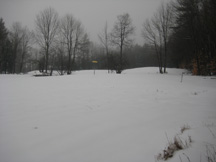 |
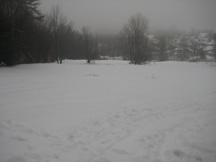 |
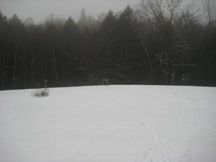 |
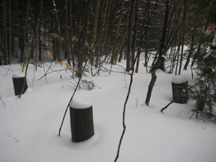 |
| Lower slope from the
base. The tow went up on the right. |
Looking down the
beginner slope. |
Unload area for the
tow. |
Pilings from the
beginner tow building. |
The Expert/Upper Slope area is a bit more
challenging to explore. At the top of the beginner's slope, with your back to
the slope, walk to the right. There, you will find some remnants of the vehicle
that powered the tow. Directly ahead and still visible is the upper tow line. As
you hike up it, it gets less distinct, with more trees across it. The line
nearly fades away completely near the summit.
To the right of the tow was the expert
slope...very hard to make out, now all forest.
Expert/Upper Slope Area
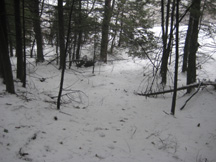 |
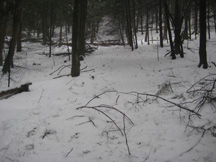 |
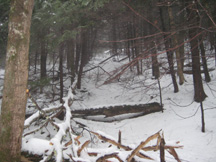 |
| Lower portion of tow
line, remnants of vehicle that powered lift visible. |
Looking up the upper
lift line - still recognizable on the lower section. |
Upper lift line higher
up - trees across, harder to define. |
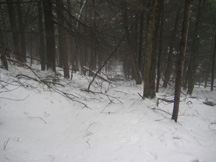 |
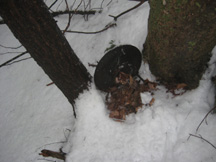 |
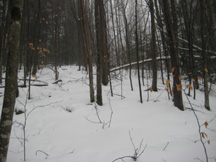 |
| Looking down the upper
tow line. |
Pulley from the tow. |
What I believe to be
the grown in expert slope...hard to define, so this is just a guess. |
Anybody else remember skiing this area? Please
share your memories.
Last updated: Feb
11, 2013
Head
back to Lost NH Ski Areas
Head
back to the Main Page











